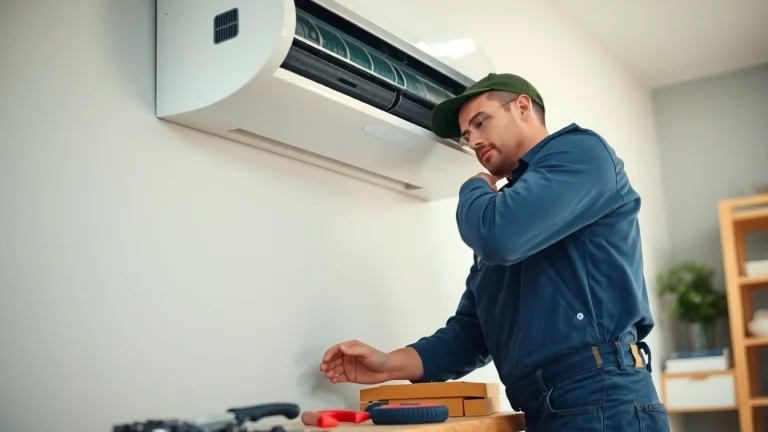
Essential Guide to Efficient Solar Panel Installation for Homeowners
Understanding Solar Panel Installation
As the world shifts towards renewable energy, solar panel installation emerges as a leading solution for homeowners looking to reduce their carbon footprint and save on energy costs. This guide will explore the fundamentals of solar panel installation, from understanding its benefits to choosing the right equipment and finding qualified professionals.
What is Solar Panel Installation?
Solar panel installation refers to the process of setting up photovoltaic (PV) systems to convert sunlight into electricity for residential or commercial use. These systems comprise solar panels, which capture sunlight, inverters, which convert the solar energy into usable electricity, and various mounting hardware to secure the panels in place. The installation process typically involves assessing the site, obtaining necessary permits, and installation by qualified technicians.
Benefits of Installing Solar Panels
Utilizing solar panels offers numerous advantages, including:
- Reduced Energy Costs: Solar panels can significantly lower electricity bills, as they provide a renewable source of energy that homeowners can use to power their homes.
- Environmental Impact: Going solar helps reduce reliance on fossil fuels, thereby decreasing carbon emissions and promoting a cleaner environment.
- Energy Independence: Solar energy allows homeowners to become less dependent on grid electricity, providing stability against rising energy prices.
- Increased Property Value: Homes equipped with solar panels often see an increase in property value, making them a wise investment for many homeowners.
Common Misconceptions about Solar Power
Despite the growing popularity of solar energy, several misconceptions persist:
- High Initial Costs: While the initial investment can be significant, numerous financing options, tax incentives, and rebates make solar installations more affordable than ever.
- Unreliable Energy Source: Solar power is often considered unreliable due to weather conditions, but battery storage technology has advanced significantly, allowing homeowners to store energy for cloudy days or at night.
- Maintenance Hassles: Solar systems require minimal maintenance, primarily cleaning the panels and occasional inspections.
Evaluating Your Home for Solar Panel Installation
Assessing Roof Suitability
Before jumping into solar panel installation, it’s essential to assess whether your home’s roof is suitable. Key factors to consider include:
- Orientation: South-facing roofs typically receive the most sunlight in the northern hemisphere, maximizing energy production.
- Roof Condition: Ensure the roof is in good repair. Installation on older or damaged roofs may not be advisable.
- Shade Assessment: Check for nearby trees or structures that could cast shade on the panels, reducing efficiency.
Understanding Local Regulations
Understanding local laws and zoning regulations is crucial when considering solar panel installation. Some areas may have specific codes regarding:
- Permitting processes
- Building restrictions
- Setback requirements for installation
- Neighborhood association rules
Identifying Solar Incentives and Rebates
To make solar panel installation more accessible, many governments offer incentives and rebates. These can significantly reduce the upfront costs. Common incentives include:
- Federal Tax Credit: In many countries, homeowners can claim a percentage of their solar system costs as a tax credit.
- State and Local Incentives: Many states provide additional rebates or tax credits that can further reduce installation costs.
Choosing the Right Solar Panels and Equipment
Types of Solar Panels Available
There are several types of solar panels available for installation, including:
- Monocrystalline Panels: Known for their high efficiency and sleek aesthetics, these panels are made from a single crystal structure.
- Polycrystalline Panels: Slightly less efficient than monocrystalline, these panels are made from multiple crystal structures and are often more affordable.
- Thin-Film Panels: Lightweight and flexible, thin-film panels can be integrated into various surfaces but typically offer lower efficiency.
Understanding Inverters and Batteries
Inverters are a critical component in a solar power system, converting DC electricity generated by panels into AC electricity used by most home appliances. There are different types of inverters:
- String Inverters: Common and cost-effective, these inverters are placed in series and work best for installations with minimal shading.
- Microinverters: Installed on individual panels, microinverters maximize individual panel performance, especially in shaded conditions.
- Battery Storage Systems: Home battery systems allow homeowners to store excess energy generated during the day for use at night or during power outages.
Key Considerations for Solar Equipment Selection
When selecting solar panels and equipment, consider the following factors:
- Efficiency Ratings: Choose panels with higher efficiency ratings for optimal energy conversion.
- Durability and Warranty: Look for panels with robust warranties and reputable manufacturers.
- Cost vs. Return on Investment: Analyze upfront costs versus long-term savings to determine financial viability.
Hiring a Professional for Solar Panel Installation
Finding Qualified Installers
Choosing a qualified installer is crucial for the success of your solar project. Look for professionals who are certified and have a solid reputation. Research online reviews and recommendations from previous customers to find a reliable contractor.
Questions to Ask Potential Installers
During consultations with potential installers, consider asking the following questions:
- What are your qualifications and certifications?
- Can you provide references?
- What warranties do you offer on products and installation?
- What financing options are available?
- How long will the installation process take?
Getting Quotes and Comparing Offers
Once you’ve shortlisted potential installers, request detailed quotes that outline:
- The total cost of installation
- Included components and features
- Projected energy savings
- Any additional fees or charges
Compare the offers and consider not just the price, but also the quality of equipment and reputation of the installation company.
Post-Installation: Maintaining Your Solar Power System
Routine Maintenance for Solar Panels
After installation, routine maintenance is essential to ensure the longevity and efficiency of your solar system. Here are some tips for maintaining your panels:
- Regular Cleaning: Keep panels clean from dust, debris, and snow to maximize sunlight exposure.
- Routine Inspections: Periodically check for any signs of damage or corrosion on the panels and connections.
Monitoring Energy Production
Monitoring your system’s performance helps ensure it operates efficiently. Most solar systems come with monitoring software that provides real-time data on your energy production and usage, enabling homeowners to see how much energy is generated versus consumed.
Understanding Warranty and Lifespan of Solar Systems
Solar panels typically come with warranties ranging from 20 to 25 years, while inverters may last 5 to 15 years. Understanding these lifespans and the terms of warranties can help plan for future maintenance or replacement needs. Regular monitoring and maintenance can significantly extend the lifespan and performance of your solar power system.


